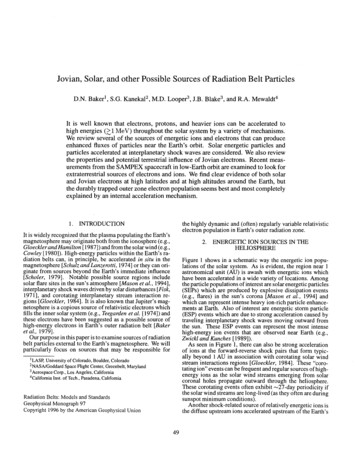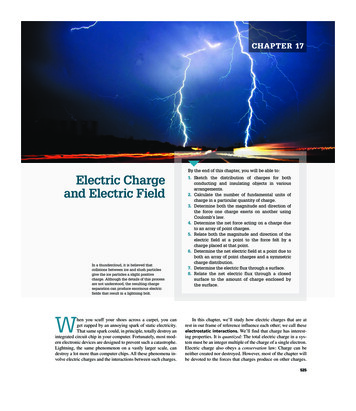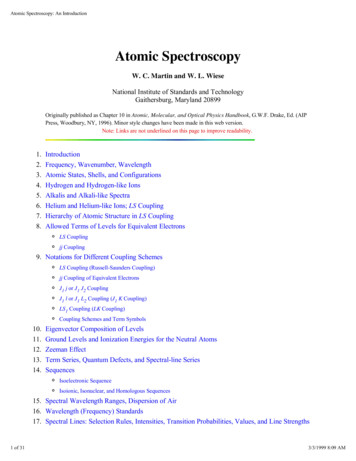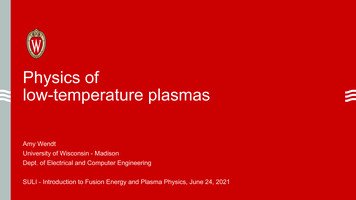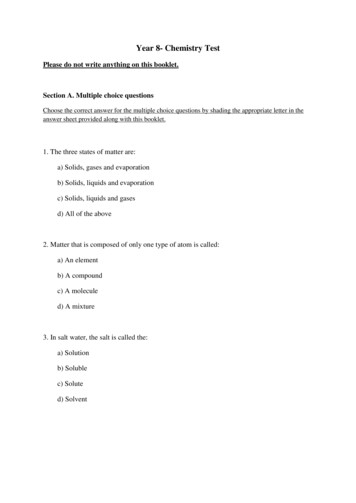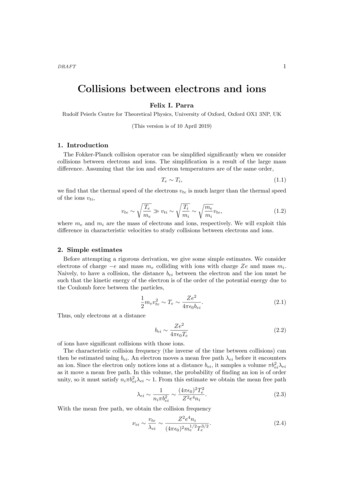
Transcription
1DRAFTCollisions between electrons and ionsFelix I. ParraRudolf Peierls Centre for Theoretical Physics, University of Oxford, Oxford OX1 3NP, UK(This version is of 10 April 2019)1. IntroductionThe Fokker-Planck collision operator can be simplified significantly when we considercollisions between electrons and ions. The simplification is a result of the large massdifference. Assuming that the ion and electron temperatures are of the same order,Te Ti ,(1.1)we find that the thermal speed of the electrons vte is much larger than the thermal speedof the ions vti ,rrrTeTimevti vte ,(1.2)vte memimiwhere me and mi are the mass of electrons and ions, respectively. We will exploit thisdifference in characteristic velocities to study collisions between electrons and ions.2. Simple estimatesBefore attempting a rigorous derivation, we give some simple estimates. We considerelectrons of charge e and mass me colliding with ions with charge Ze and mass mi .Naively, to have a collision, the distance bei between the electron and the ion must besuch that the kinetic energy of the electron is of the order of the potential energy due tothe Coulomb force between the particles,1Ze22me vte Te .24π 0 bei(2.1)Thus, only electrons at a distancebei Ze24π 0 Te(2.2)of ions have significant collisions with those ions.The characteristic collision frequency (the inverse of the time between collisions) canthen be estimated using bei . An electron moves a mean free path λei before it encountersan ion. Since the electron only notices ions at a distance bei , it samples a volume πb2ei λeias it move a mean free path. In this volume, the probability of finding an ion is of orderunity, so it must satisfy ni πb2ei λei 1. From this estimate we obtain the mean free pathλei 1(4π 0 )2 Te2 .ni πb2eiZ 2 e4 ni(2.3)With the mean free path, we obtain the collision frequencyνei vteZ 2 e4 ni .1/2 3/2λei(4π 0 )2 me Te(2.4)
2Felix I. ParraThis estimate ignores the fact that weak collisions between particles separated by theDebye length λD dominate. To include the effect of these weak collisions, we only needto recall that we estimated the effect of weak collisions to be larger than the effect ofcollisions between particles at a distance bei by a Coulomb logarithm ln Λei 1. A largereffect is roughly equivalent to more collisions, that is, it is equivalent to a larger collisionfrequency. Then, we need to multiply (2.4) by a factor of ln Λei to obtainνei Z 2 e4 ni ln Λei1/23/2(4π 0 )2 me Te.(2.5)Similar estimates give us the typical collision frequency of electron-electron collisions andion-ion collisions,νee e4 ne ln Λee1/23/2(4π 0 )2 me Te(2.6)andνii Z 4 e4 ni ln Λii1/23/2(4π 0 )2 mi Ti.(2.7)The estimate that led to (2.5) is not valid for the effect of ion-electron collisions onions. It is true that electrons and ions collide often, but the effect of a single collision onan ion is small. Due to conservation of momentum, if the change of the electron velocityin a collision is ve , the change to the ion velocity isrmememe vi ve vte vti vti .(2.8)mimimiTherefore, a single electron-ion collision only modifies the ion velocity by a small amountof the order of (me /mi )1/2 vti vti . This type of collision that only changes the velocityby a small amount can be thought of as a random walk in velocity space. To achievea total change in the ion velocity of the order of vti , we need a large number Nc ofelectron-ion collisions, 2vtimiNc 1.(2.9) vi meThen, the effective collision frequency of ion-electron collisions is 1/Nc smaller than theelectron-ion collision frequency,1/2νie νeimeZ 2 e4 ni me ln Λei νei .3/2Ncmi(4π 0 )2 mi Te(2.10)Combining equations (2.5), (2.6), (2.7) and (2.10), and assuming Te Ti , Z 1 andne ni , we obtainrmemeνei νie νei .(2.11)νee νei νii mimiThe electrons collide with electrons as often as they collide with ions. Ions collide withions much more rarely, and ions are affected by their collisions with the light electronsonly after a time much longer than the time between collisions with other ions.
Collisions between electrons and ions33. Electron-ion collision operatorWepions. We perform an expansionp start with the effect on electrons of collisions within me /mi 1. We first consider the lowest order in me /mi 1, and later we keephigher order terms.p3.1. Electron-ion collision to lowest order in me /mi 1The electron-ion Fokker-Planck collision operator is#)(Z"γeife (v)fi (v0 )3 00Cei [fe , fi ] v · g g g · v fe (v) v0 fi (v ) d v .memm e {z } i {z } fi fe / me Te(3.1) fi fe / mi TiTo find the order of magnitude estimate, we have used v fe fe /vte and v0 fi fi /vti .0The term m 1i fe (v) v 0 fi (v ) is then negligible. Moreover, we findg {z}v {z}v0 ' v, vte(3.2) vtileading tov 2 I vv.(3.3) g g g ' v v v v3RWiththis result, and using fi (v0 ) d3 v 0 ni , equation (3.1) becomes to lowest order inpme /mi 1 2 v I vvγei ni v ·· v fe .(3.4)Cei [fe , fi ] ' Lei [fe ] m2ev3This approximate operator is known as Lorentz collision operator or pitch-angle scatteringcollision operator.To understand the pitch-angle scattering operator, we rewrite it using the sphericalcoordinates {v, α, β} in velocity space, shown in figure 1. In the orthonormal basis {v̂ v/v, α̂ v α/ v α , β̂ v β/ v β }, the gradient and divergence with respect to thevelocity of general functions f and Γ are v f v v f f f f1 f1 f v α v β v̂ α̂ β̂ v α β vv αv sin α β(3.5)and 1 (J Γ · v v) (J Γ · v α) (J Γ · v β)J v α β 1 1 1 2v 2 Γ · v̂ (sin α Γ · α̂) Γ · β̂ ,v vv sin α αv sin α β v · Γ (3.6)where J det[ v/ (v, α, β)] [ v v · ( v α v β)] 1 v 2 sin α is the determinantof the Jacobian of the transformation v(v, α, β). Using (3.5) and (3.6), equation (3.4)becomes γei ni1 fe1 2 feLei [fe ] 2 3sin α .(3.7)me v sin α α αsin2 α β 2The Lorentz operator diffuses the distribution function in α and β, but leaves its structurein v unchanged. The reason for this lack of diffusion in v is that electrons do not changethe magnitude of its velocity when they collide with heavy ions. According to (2.8), thevelocity of the ion barely changes in a collision with an electron. Then, the ion kinetic
4Felix I. Parraẑv̂ˆv ˆ ŷx̂Figure 1. Spherical coordinates {v, α, β} in velocity space. The orthonormal basis{v̂ v/v, α̂ v α/ v α , β̂ v β/ v β } is also sketched.energy does not change, and since the total kinetic energy of both the electron and the ionis conserved, the kinetic energy of the electron is the same before and after the collision.Thus, only the direction of the electron velocity changes after a collision, leading to thediffusion in α and β seen in (3.7).The Lorentz operator tends to make the electron distribution function isotropic, thatis, it tends to give a function fe that is only a function of v and not of α or β. To show thisproperty, we prove that the Lorentz operator satisfies its own H-theorem. The entropyproduction due to the Lorentz operator isZLσ̇ei ln fe Lei [fe ].(3.8)Using (3.4) and integrating by parts, we obtainZγei niv 2 I vvLσ̇ei fe v ln fe ·· v ln fe d3 v2mev3Z2fev · v ln feγei nid3 v lnf v vem2evv2" 2 2 #Zγei nife fe1 fe d3 v 0.m2ev3 αsin2 α β(3.9)LLThus, the entropy grows until σ̇ei 0. The entropy production σ̇eivanishes only when v ln fe is proportional to v, that is, when fe (v) is only a function of the velocity magnitude. Interestingly, we did not need to add the entropy production of the ions due toelectron-ion collisions to show that the entropy increases. The isotropizationp process isthen independent of the ion distribution function because to this order in me /mi 1,the ions seem just stationary particles compared to the fast electrons.3.2. Electron-ion collision to first order inpme /mi 1We have argued in (2.11) that the electron-ion collisions are much more frequent thanother types of collisions. Thus, it is usual to have an electron distribution function that
5Collisions between electrons and ionspis isotropic to lowest order in me /mi 1,fe (v) fe0 (v) fe1 (v) . . . {z } q{z }isotropic memi(3.10)fe0If this is the case,pwe need to continue the expansion of the electron-ion collision operatorto next order in me /mi 1. For g g g, instead of the lowest order approximationin (3.3), we keep the next order correction to find g g g M(g) M(v v0 ) ' M(v) v0 · v M(v) v v v v0 · v v v v. (3.11)Substituting this result and the expansion in (3.10) into (3.1), we obtain(Z ": 0 due to isotropy γeifi (v0 ) v · v v· f(v) v v v · v fe1 (v)Cei [fe , fi ] ' vv e0meme #) f (v)e0003 0 v · v v v v · v fe0 (v) v v v · v0 fi (v ) d v .mi(3.12)Using1 fe0v,v vZZZfi (v0 ) d3 v 0 ni ,fi (v0 )v0 d3 v 0 ni ui , v0 fi (v0 ) d3 v 0 0, v fe0 (v) and(3.13)(3.14)the electron-ion collision operator in (3.12) can be rewritten asγei ni v ·Cei [fe , fi ] 'm2e!1 fe0 v v v · v fe1 ui · v v v v · v .v v(3.15)One further useful manipulation is:0 *· I v v. v v v v · v v ( v v vv v · v) v vv v(3.16)With this result equation (3.15) finally becomes" #γei niui fe0Cei [fe , fi ] ' v · v v v · v fe1 m2ev v" # γei niv · ui fe0v · ui fe0 v · v v v · v fe1 Lei fe1 .m2ev vv v(3.17)The electron-electron collisions are usually as frequent as the electron-ion collisions (see(2.11)), and as a result, it is usually the case that the lowest order electron distributionfunction is not only isotropic, but also Maxwellian, 3/2 me v 2mefe0 (v) fM e (v) neexp .(3.18)2πTe2TeIf this is the case, equation (3.17) becomes me v · uiCei [fe , fi ] ' Lei fe1 fM e .Te(3.19)
6Felix I. ParraWe have seen that the Lorentz operator tends to make the distribution functionisotropic. Thus, the collision operator in (3.17) will givev · ui fe0.(3.20)v vwhere ge1 (v) is isotropic. When calculating the total distribution function fe ' fe0 (v) fe1 (v), we can absorb the isotropic correction ge1 (v) into the lowest order isotropic distribution function fe0 (v), leading tofe1 (v) ge1 (v) fe0v · ui fe0' fe0 (v) ( v ui v)' fe0 ( v ui ).(3.21)v v vThen, the electron-ion collisions tend to give an electron distribution function that isisotropic around the average velocity of the ions ui .We proceed to calculate the collisional friction force and the collisional energy exchangeusing (3.17).fe (v) ' fe0 (v) 3.2.1. Electron-ion collisional friction forceThe collisional force on the electrons isZFei me v Cei [fe , fi ] d3 v.(3.22)Substituting equation (3.17) into this expression, and integrating by parts, we find Zγei ni*·I v · f ui fe0 d3 v vFei v vv e1 vmev v Zγei niui fe0 v v v · v fe1 d3 v.(3.23)mev vIntegrating by parts the first term in the integral, we find Z γei niv 2 I vv fe0Fei fe1 2v v v ·ud3 v.imev4 v(3.24)To simplify the integral further, we use that fe0 (v) is isotropic, and we take the integral inthe spherical coordinates sketched in figure 1. Since v v[sin α(cos β x̂ sin β ŷ) cos α ẑ],the integral over the angles α and β givesZ πZ 2πv21v2dα(3.25)dβ sin αvv (x̂x̂ ŷŷ ẑẑ) I.4π 0330Then,Z v 2 I vv fe0 38π fe08πfe0 (0)dv Idv I.v4 v3 v30Using this expression, and employing h v i v · v v · v v 2v v v v [ v · ( v v)] v v · v vvv2 3 v·v22v v 3 v 3,vvvvZ(3.26)(3.27)equation (3.24) becomesγei niFei me 8πfe0 (0)ui 23Z v3fe1 d v .v3(3.28)
7Collisions between electrons and ionsThe friction force depends on the average ion velocity and on a moment of the correctionto the electron distribution function fe1 . Note that only the value of fe0 at v 0 entersin the expression, and that the integral over fe1 is weighed towards smaller v due tothe factor v 3 . Low energy electrons determine the friction force because they are morelikely to collide with ions.Expression (3.28) becomes more transparent if we assume that the electron distributionfunction is a Maxwellian with average velocity ue ui vte , 3/2 me v ue 2meexp fM e ( v ue )fe (v) ne2πTe2Teme v · uev · ue fM e(3.29)' fM e (v) fM e (v) fM e (v), {z }v vTe{z} fe0 (v)fe1 (v)where fM e (v) is the stationary Maxwellian defined in (3.18). In this simple case, 3/2mefe0 (0) fM e (0) ne,(3.30)2πTeand using (3.25), we find thatZZme (v · ue )vv3fdv fM e d3 ve1v3v 3 Te 5/2 Z 3/2 me2ne ue me2neme v 2 v dv ue . (3.31)exp 2Te3 2π Te3 2π Te0With these results, equation (3.28) becomesFei ne me νei (ui ue ),where the electron-ion collision frequency is defined to be 4 2π Z 2 e4 ni ln Λei4γei ni .νei 3/23/23 (4π 0 )2 m1/23 2π m1/2e Tee Te(3.32)(3.33)3.2.2. Electron-ion collisional energy exchangeThe collisional energy gained or lost by the electrons isZ1Wei me v 2 Cei [fe , fi ] d3 v.2(3.34)Substituting equation (3.17) into this expression, and integrating by parts, we find 2 Zγei nivui fe0Wei v· v v v · v fe1 d3 vme2v v Z:0γei niui fe0 v· v· f d3 v 0.(3.35) v e1 v vmv vepTo this order in the expansion in me /mi 1, there is no exchange of energy. Themagnitude of the velocity of the electron barely changes in one collision, and as a result,the transfer of energy is minimal. To calculate the energy transfer, it is better to use theion-electronp collision operator than to expand the electron-ion collision operator to nextorder in me /mi 1.
8Felix I. Parra4. Ion-electron collision operatorWe proceed topcalculate the effect on ions of collisions with electrons. We performan expansion in me /mi 1. To simplify the problem, we assume that the electrondistribution function is almost isotropic and hence it can be expanded as in (3.10).The ion-electron Fokker-Planck collision operator is)#(Z"γeifi (v)fe (v0 )3 00Cie [fi , fe ] g g g · v · v fi (v) v0 fe (v ) d v . (4.1)mimm} e {z } i {z fi fe / mi Ti fi fe / me Te0The term m 1i fe (v ) v fi (v) is then small, and we can use the lowest order approximationfe (v) ' fe0 (v) in it. We also havev0 ' v0 ,g {z}v {z} vti(4.2) vteleading to g g g M(g) M(v v0 ) ' M( v0 ) v · v0 M( v0 ) v0 v0 v 0 v · v0 v0 v0 v 0 .(4.3)With these results, equation (4.1) becomesγeiCie [fi , fe ] ' v ·mi:0 0 fe0 (v 0 )fi (v) 00 v0 v0 v · v fi (v) v0 v0 v · v0 fe0 (v )mime #) 00003 0 v0 v0 v · v0 fe1 (v ) v · v0 v0 v0 v · v0 fe0 (v ) d v .(Z "(4.4)Using (3.13) and (3.16), we find v0 v0 v0 v 0 · v0 fe0 (v 0 ) 1 fe0 (v 0 ) v 0 v 0 v 0 .v 0 v 0(4.5)Employing (3.23), we obtainZZγeiFeiγei1 fe0 (v 0 )003 0000 v0 v0 v 0 d3 v 0 . v v v · v fe1 (v ) d v ui ·mi meni m imi mev 0 v 0(4.6)With these results, equation (4.4) becomes(Z "γeife0 (v 0 )Fei· v fi v · v0 v0 v 0 · v fi (v)Cie [fi , fe ] 'ni mimimi#)fi (v) fe0 (v 0 )03 0 (v ui ) · v0 v0 v d v .(4.7)me v 0 v 0We finish by taking the integrals in v0 . Using (3.25) and v0 v0 v 0 [(v 0 )2 I v0 v0 ]/(v 0 )3 ,we findZZ 8π00 3 000fe0 (v ) v v v d v Ife0 (v 0 )v 0 dv 0 .(4.8)30
Collisions between electrons and ions9Using this result and (3.26), equation (4.7) finally becomes"#Z Fei8πγei fe0 (0) v fi000fe0 (v )me v dv (v ui )fi .Cie [fi , fe ] '· v fi v ·ni mi3mi memi fe0 (0) 0(4.9)If the electron distribution function is a Maxwellian (see (3.18)), this operator simplifiesto"#ne me νeiFeiTe· v fi v · v fi (v ui )fi ,Cie [fi , fe ] '(4.10)ni mini mimiwhere νei is defined in (3.33).We proceed to calculate the collisional friction force and the collisional energy exchange.4.1. Ion-electron collisional friction forceThe collisional force on the ions isZFie mi v Cie [fi , fe ] d3 v.(4.11)Substituting equation (4.9) into this expression, and integrating by parts, we find#ZZ "Z 8πγei fe0 (0) v fiFei3000fi d v fe0 (v )me v dv (v ui )fi d3 v.Fie ni3memi fe0 (0) 0(4.12)Using (3.14), the collisional force becomesFie Fei ,(4.13)as expected.4.2. Ion-electron collisional energy exchangeThe collisional energy gained or lost by the ions isZ1mi v 2 Cie [fi , fe ] d3 v.Wie 2(4.14)Substituting equation (4.9) into this expression, and integrating by parts, we findZZ "Z 8πγei fe0 (0)v · v fiFei3Fie · fi v d v fe0 (v 0 )me v 0 dv 0ni3memi fe0 (0) 0# v · (v ui )fi d3 v.Using thatRfi (v ui ) d3 v 0, we can writeZZ3fi v · (v ui ) d v fi v ui 2 d3 v.By integrating by parts, we obtainZZZ33v · v fi d v fi ( v · v) d v 3 fi d3 v 3ni .(4.15)(4.16)(4.17)
10Felix I. ParraWith these results, equation (4.15) becomes!Z Z1mi v ui 2 318πγei ni fe0 (0)000fe0 (v )me v dv fid v .Wie Fei ·ui mi mefe0 (0) 0ni3(4.18)For an electron Maxwellian distribution function (see (3.18)) and an ion Maxwelliandistribution function 3/2 mi v ui 2miexp ,(4.19)fi (v) fM i (v) ni2πTi2Tithe collisional energy exchange becomesWie F · ui{z } eiwork done by friction force 3ne me νei(Te Ti ).mi(4.20)The first term in (4.20) is the work done by the collisional force Fie Fei on theions. The second term is a collisional energy exchange proportional to the temperaturedifference between electrons and ions. This term will tend to make the ion and electrontemperatures equal, but at the slow ratene m eνei νii νee νei .(4.21)ni miThen, the ions and electrons can have many collisions and their distribution functionsbecome Maxwellians without their temperatures becoming equal. For this reason, it ispossible to find plasmas with very different electron and ion temperatures.Due to energy conservation, the electron energy gain or loss isWei Wie Fei · ui Fei · ue {z }3ne me νei(Te Ti )miwork done by friction force Fei · (ui ue ) {z}3ne me νei(Ti Te ).mi(4.22)Joule heatingThis collisional energy gain has the work done by the friction force Fei on the electrons,and the energy exchange due to the temperature difference, but in addition to these twoterms, it contains Joule heating. This Joule heating term is due to the transfer of energyfrom the average electron flow to the electron temperature.
3. Electron-ion collision operator We start with the e ect on electrons of collisions with ions. We perform an expansion in p m e m i 1. We rst consider the lowest order in p m e m i 1, and later we keep higher order terms. 3.1. Electron-ion collision to lowest order in p m e m i 1 The electron-ion Fokker-Planck collision operator is C ei[f .

